
Traditional Recipes
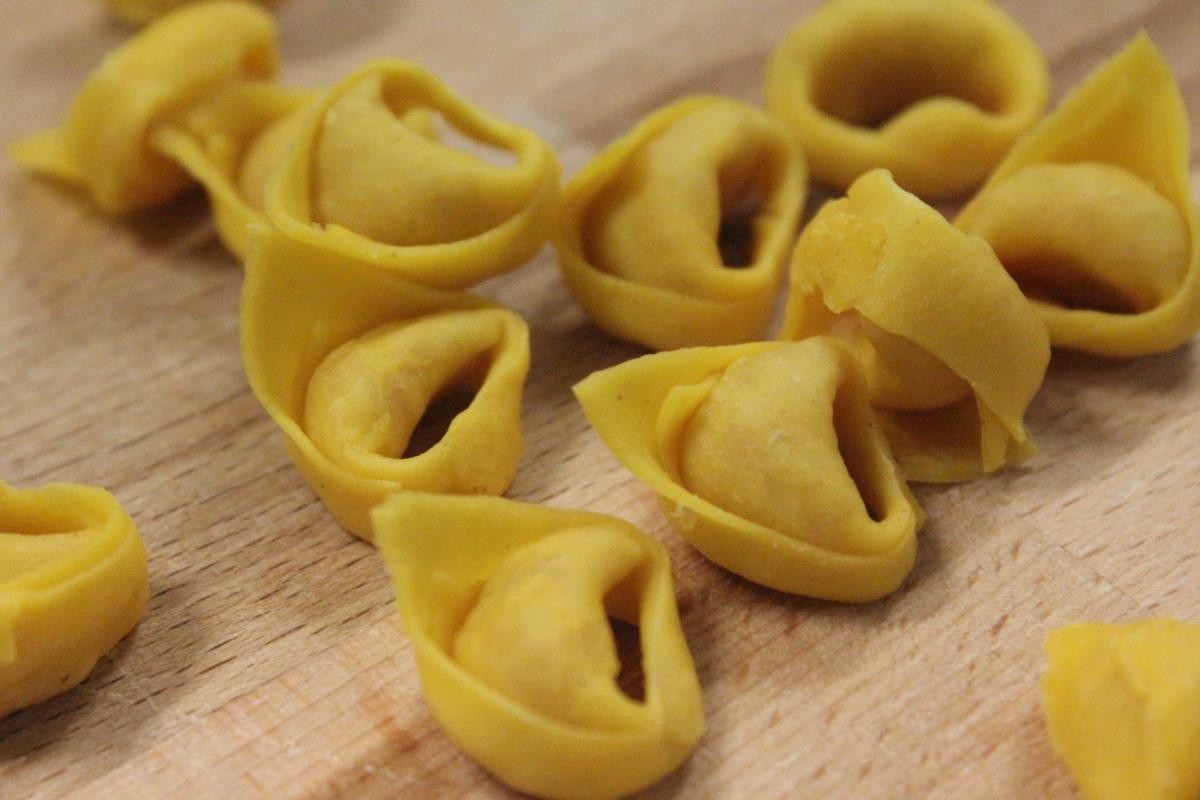
Tortellini in broth
Tortellini, one of the most famous first courses of the Emilia-Romagna region, is a true Christmas classic, especially in the area between Bologna and Modena. But where and how did they even come up with this dish? What is the original recipe?
First of all, tortellini is a traditional Christmas dish: it takes long to prepare and requires all hands on deck, which is why it is great for family gatherings. Just like in an assembly line, everyone has to do their part, be it rolling the dough, cutting the squares, making the filling or gently wrapping the filled pasta parcel around their little finger to create tortellini shapes.
More
There is still some debate over the origin of this dish. According to Giuseppe Ceri’s parody of “La Secchia Rapita” (“The Stolen Bucket”, a poem by Alessandro Tassoni), one day, when Venus, Mars and Bacchus visited a tavern in Castelfranco Emilia (a town located halfway between Bologna and Modena), the innkeeper inadvertently caught Venus in a state of undress. The man was so astonished at the sight of the goddess’ navel that he ran into the kitchen and created tortellini in her honour.
According to historical sources, the origins of this dish can be traced back to as early as the Middle Ages: a scroll dated 1112 reads “Tertia parte turtellorum monachorum est” (a third of tortellini goes to the monks), while from a bull issued by Pope Alexander III in 1169 we know that each church was assigned “duas partes turtellorum” (two parts of tortellini).
However, it was only in the 18th and 19th century that the word tortellini started to be used and the “official” recipe was set down, when for the first time the Christmas lunch menu of the monastery of San Michele in Bosco featured a tasty “tortellini soup” and Italian writer Pellegrino Artusi shared a tortellini filling recipe in his masterwork “La scienza in cucina e l’arte di mangiar bene” (“Science in the Kitchen and the Art of Eating Well”).
But what about the official recipe? Since there are many versions of the dish and each family has their own recipe, we decided not to pick favourites and went with the one that was registered with the Chamber of Commerce of Bologna by the Dotta Confraternita del Tortellino (“Brotherhood of Tortellino”).
Tortellini in broth - Recipe
For about 1,000 tortellini
Ingredients
Pasta dough: 3 eggs and 300 g flour
For the filling: 300 g pork loin browned in butter, 300 g raw ham, 300 g Mortadella Bologna, 400 gr Parmigiano-Reggiano cheese, 3 eggs, 1 ground nutmeg.
For the broth: 1 kg beef (flank steak), 1/2 free-range hen, celery, carrot, onion, salt.
Method
To prepare the filling, finely mince the meat then add the eggs, grated Parmigiano cheese, and nutmeg. Blend thoroughly and set aside to cool in the fridge for at least 12 hours.
For the broth, put the meat and the hen in a pot. Pour over 4 litres of cold water, bring the temperature up to the boil, then skim off the foam that comes to the top. Add vegetables, a little salt, and let it simmer for at least 3 hours.
Using a rolling pin, roll out the pasta on a pastry board until very thin. Cut out 3cm squares, then place 1 teaspoon of filling in the middle of each square of pasta. Fold the dough over into a triangle, then set the pocket of filling against the nail of your finger and wrap the two corners around your finger. Press tightly to seal. Set aside on a well-floured baking sheet and repeat.
Strain the stock, discarding the vegetables and meat pieces, and bring it to the boil again. Then cook the tortellini in the stock for about 3/4 minutes over a medium heat. Serve very warm with parmesan grated on the top.

Cappelletti in broth
This is the most popular Christmas dish in Romagna. Even though cappelletti and tortellini may look similar, they are actually different in terms of both shape and filling. Cappelletti are traditionally prepared by the whole family on the days before Christmas and served in hot broth.
They can be stuffed with either cheese or, according to the traditional recipe, mixed minced meat.
MoreCappelletti get their name from their rounded shape, which resembles a “little hat”, more specifically the hat worn by priests, who were said to go crazy for this dish.
The broth used for cappelletti is also rooted in culinary tradition and should be prepared with very specific beef and pork cuts, as well as capon. The meat should be put in cold water with herbs and a parmesan rind, then left to simmer for several hours.
Cappelletti in broth - Recipe
Ingredients (4 serves)
For the cheese filling:
100 gr soft cheese (stracchino or squacquerone)
For the meat filling:
200 gr mixed minced meat
150 gr ricotta cheese
150 gr Parmigiano-Reggiano cheese (freshly grated)
3 eggs
Lemon zest
Nutmeg
Method
Combine the cheeses, grate the zest of half a lemon, add some grated nutmeg (careful not to add too much!) and the eggs, then mix.
Take the sheet of pasta, cut it into 3cm squares, place small pinches of filling in the centre of each square and fold into a triangle, pressing the edges to seal. Then overlap the bottom two corners and press to seal them together to form a cappelletti shape.
(source: riviera.rimini.it)
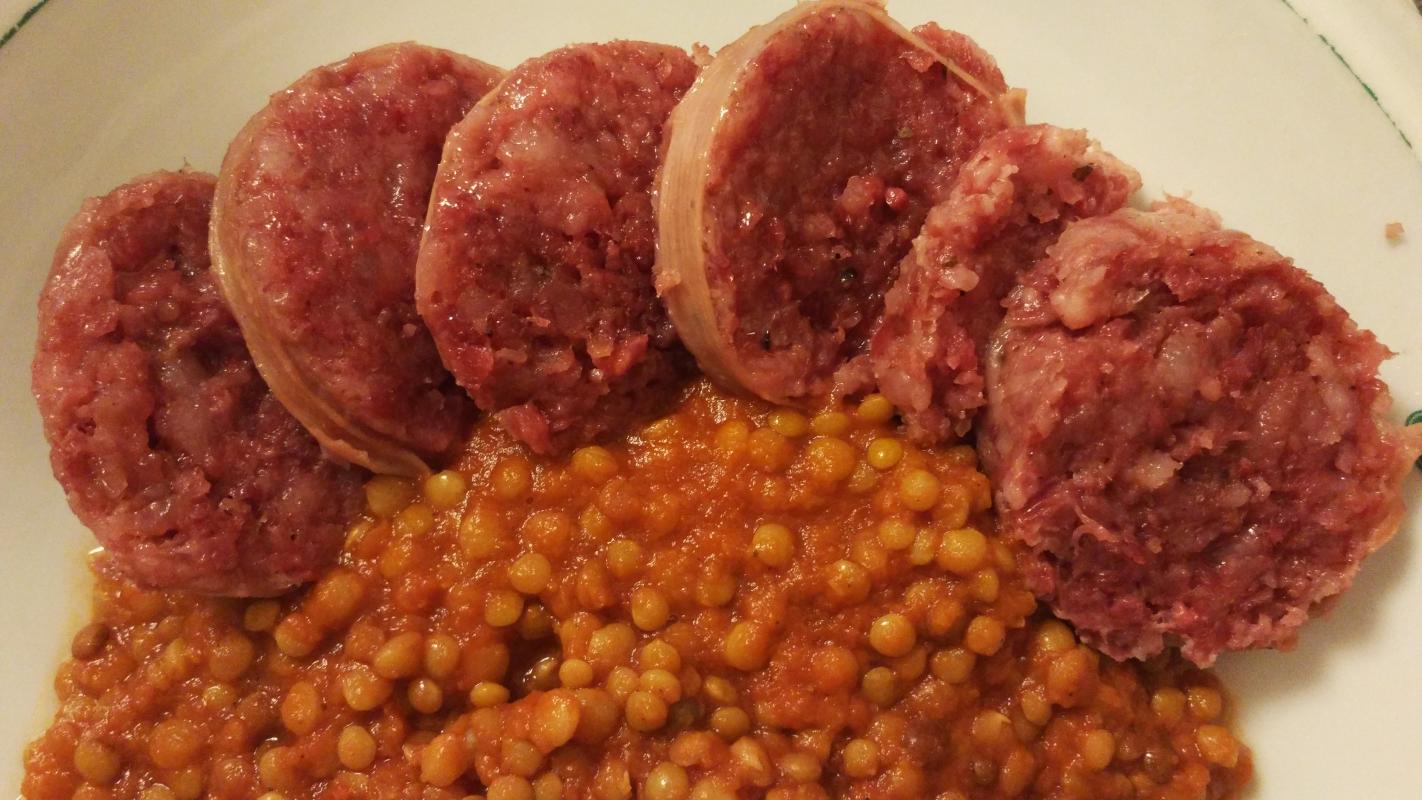
Zampone and Cotechino
In some areas of the Emilia-Romagna region, especially in the province of Modena, it is not Christmas or New Year’s Day without Zampone and Cotechino. They are the staple of any New Year’s Eve dinner.
The origins of these poached pork sausages are quite certain: tradition has it that in the hard winter of 1511 the people of Mirandola, who were nearly starving to death during the siege of Pope Julius II, started filling up pig intestines and pork legs with pork rind and several other pork cuts.
MoreDespite there being a number of variations from producer to producer, the recipe has remained relatively unchanged and calls for the pig’s head, throat and shoulder mixed with salt and spices.
As we said before, no New Year’s Eve dinner is complete without zampone or cotechino served with lentils, which Italians consider to be good luck when eaten after the stroke of midnight at new year.
Blessed (hard-boiled) eggs on Easter morning
It may sound funny, but this is a deeply felt tradition in several rural areas of Romagna and sometimes Emilia. As a matter of fact, blessed hard-boiled eggs are almost mandatory for Easter breakfast in several towns across the region.
You will find that they are very easy to make, since it is the hen that does most of the work… Whether from the grocery store or from the hen house, eggs are washed, cleaned, and then boiled (remember: one egg for each person having breakfast!). Sometimes they are also nicely decorated.
MoreAccording to tradition, on Holy Saturday the eggs are brought to Church in a decorated basket to be blessed and are not to be eaten until Easter morning for good luck.
Fun fact: many Italian people will tell you it was torture having to eat the hard-boiled egg (or at least half of it, in order not to upset grandma), when the table was full of all kinds of treats and chocolate eggs!
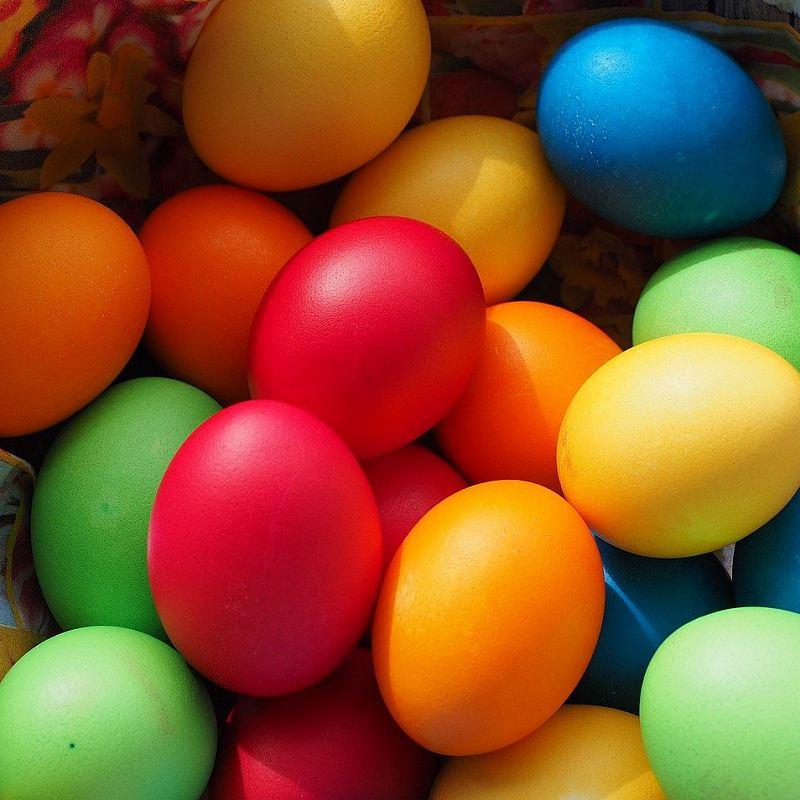
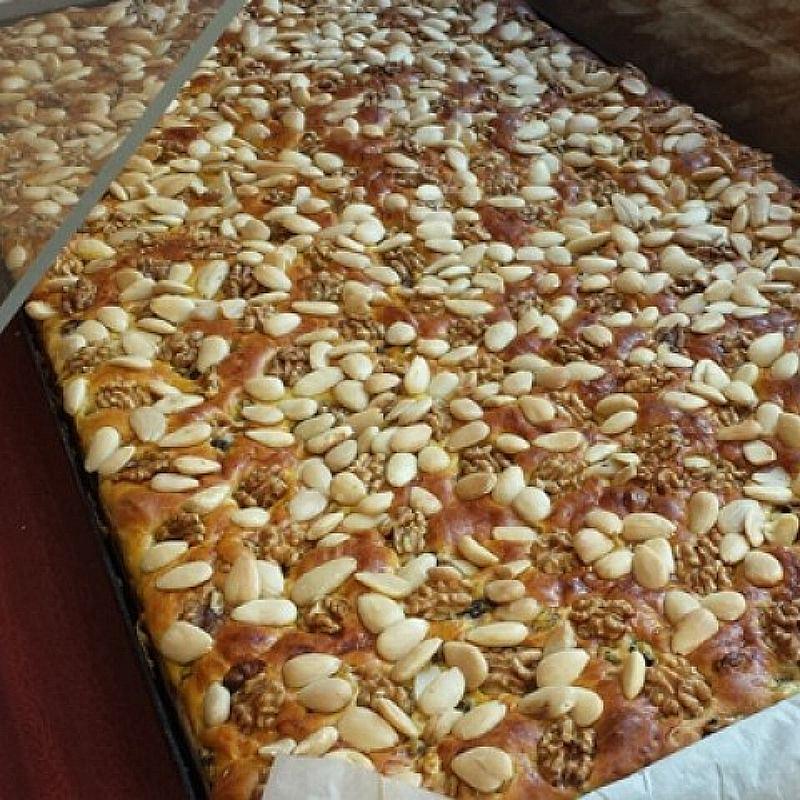
Piada dei morti (all souls’ day sweet bread)
Piada dei Morti is one the most delicious baked goods of Romagna. Despite its name, it has very little in common with the traditional piada or piadina (Romagna’s typical flatbread) and looks more like focaccia stuffed with nuts and raisins.
Some recipes add must to the dough, which is why Piada dei Morti can only be found between October and early November, when grapes are harvested and the wine is bottled.
Some say its origins are lost in the mists of time, dating as far back as the Celts. Legend has it that this delicious sweet bread was prepared every year on the night between October 31 and November 1 (Celtic New Year) to attract wandering spirits and help the souls of the deceased find their way back home to visit their loved ones for one night.
MoreMyths and legends aside, today Piada dei Morti is still a favourite in many Romagna households on All Saints’ Day.
La piada dei morti - Recipe
Ingredients:
250 gr flour
25 gr brewer's yeast melted in warm milk
50 gr sugar
Raisins (to taste)
A pinch of salt
3 eggs
50 gr melted butter
A handful of walnuts, a handful of almonds, and a handful of pine nuts
Method
Put the flour on a pastry board and make a well in the centre, then add yeast, sugar, salt, 2 eggs, butter, and raisins. Mix all these together, then pour the dough into a bowl and let rise for 2-3 hours.
Spread the dough onto a baking sheet and let rise for an additional hour.
Add the walnuts, almonds, and pine nuts, then brush the dough with egg wash (mixed with some sugar). Bake it in a preheated 200 degrees oven for about 30 minutes.
(source: riviera.rimini.it)
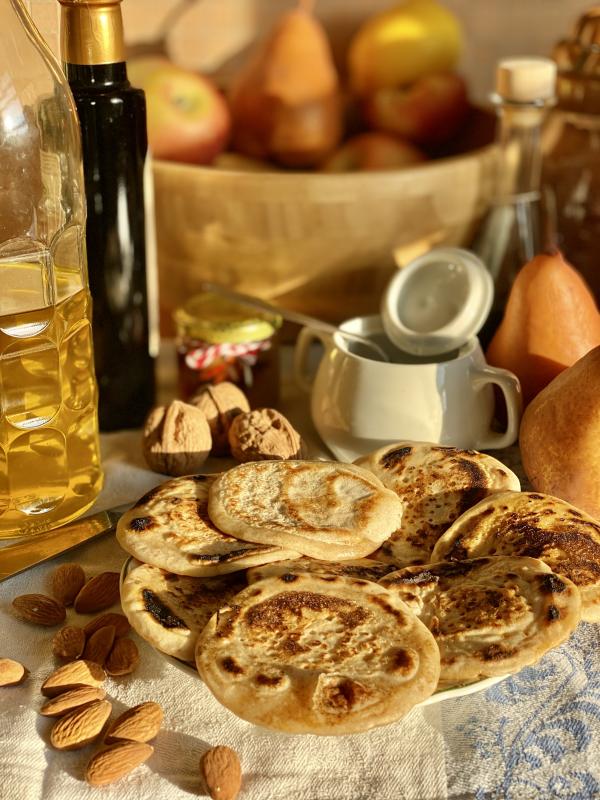
Cantarelle
Originally poor people’s food, cantarelle are already quite popular throughout Romagna but definitely deserve more recognition: with very few ingredients (water, flour, salt, sugar, and extra-virgin olive oil) they can be considered a beginner-friendly, vegan version (no eggs nor milk) of pancakes.
Traditionally eaten on Sundays, for breakfast or as a snack, cantarelle are very easy to prepare and a true crowd-pleaser. For the best result, make sure to use a flat pan (like the one used to cook piadina, a thin Italian flatbread) or a non-stick frying pan.
MoreAlthough they were originally served topped with olive oil and sugar, they also taste amazing with honey and jam, maple syrup, berries, cooked black cherries, and any other topping you can think of!
Cantarelle . Recipe
Ingredients:
500 gr water
500 gr flour
1 pinch of salt
Extra-virgin olive oil to serve (to taste)
Sugar to serve (to taste)
Method
Put warm water, flour and a pinch of salt into a bowl, then whisk to a smooth batter. Set aside for half an hour while heating up your pan. When hot, pour the batter onto the pan with a ladle and spread out gently into a round shape. Cook until golden on both sides, then transfer to a platter and serve with oil and a sprinkle of sugar.
Cantarelle also taste delicious with honey, jam, and… hazelnut cream or chocolate!
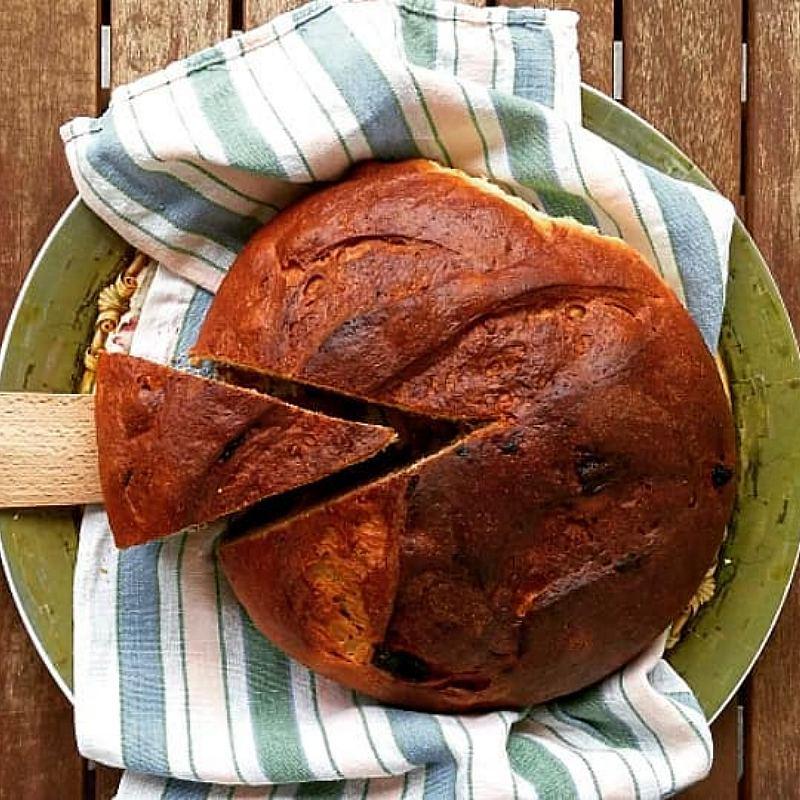
Pagnotta di Sarsina – Cammino di San Vicinio
Tipico dolce di Sarsina e dintorni, presente anche sulle tavole dei più poveri, simbolo della festività Pasquale. Le“azdore” cominciavano a prepararlo sin dalle Sacre ceneri con un lungo ed attento rituale che iniziava al calare della sera della settimana Santa. La pagnotta, una volta cotta, era tolta dal forno e lasciata raffreddare sopra l’asse del pane, poi chiusa nella madia fino al giorno di Resurrezione. Nel passato nel giorno di Pasqua, al ritorno della Messa, la famiglia riunita attorno alla tavola imbandita accoglieva il fiore della primavera, in comunione con le uova sode benedette, salame stagionato e Sangiovese. Oggi la tradizione continua nella realizzazione della Pagnotta, che è ancora sottoposta a tre fasi di lievitazione, in cui viene ancora impresso il simbolo della croce. E’ ancora mangiata la mattina di Pasqua con gli stessi accostamenti. Il prodotto è realizzato ancora nella sua forma di cupola, da peso di due chili ( forma tradizionale), ma oggi è realizzata anche quella dal peso di un chilo.
MoreA Sarsina il pane dolcificato dei padri si fa ancora presso i fornai locali.
Questa è la ricetta tradizionale, pubblicata da Vittorio Tonelli nel suo libro "A tavola con il contadino romagnolo"
- due chili di farina di grano;- uno di pasta lievitata;
- sette etti di zucchero;-un etto mezzo di strutto (o margarina);
- dieci uova;-buccia grattugiata di due o tre limoni;
- due bustine di vaniglia;-un pugno di lievito di birra;
- un pizzico di sale e, volendo, dell'uva secca.
L'impasto, a forma di cupola, si lascia lievitare ore e ore, in attesa della cottura, che dovrà avvenire a fuoco lento, nel forno, sopra fogli di carta straccia. Prima, però, va "pennellato" con uova sbattute e superficialmente tagliato in alto perché abbia a "fioccare" bene. A cottura ultimata (dopo un'ora circa), la pagnotta si presenta nella sua profumata mole marroncina, alta venti centimetri e con un diametro base di quaranta. Un momento delicato e importante è quello ella lievitazione, che necessita di un ambiente caldo a temperatura costante.
Fonte “Gustando. Storie di Romagna” – Pro Loco di Sarsina e- Cammino di San Vicino
Dolci di Natale - Tortellini fritti e al forno
Dolci natalizi ripieni con crema pasticcera, marmellata, o con il tradizionale pasto natalizio a Reggio Emilia. I tortellini di Natale al forno o fritti (Turtlein d’Nadel al foren o frett) sono un dolce tipico della tradizione reggiana, che deriva addirittura dalla cucina rinascimentale, caratterizzata dall'unione dell’agro e del dolce. Sono ripieni di crema pasticcera, marmellata, o di pesto natalizio, uno squisito ripieno fatto di marmellate, castagne, noci, pinoli, caffè in polvere, rum o sassolino), conosciuti soprattutto nel reggiano e nel modenese.
Fonte: Via Matildica del Volto Santo – Comune di Vezzano Sul Crostolo
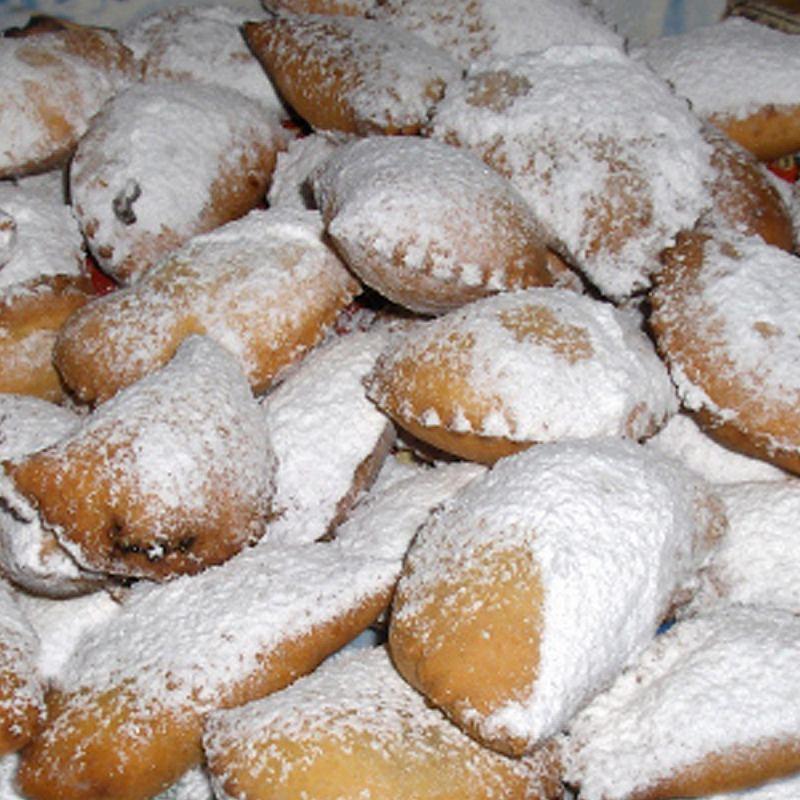
Tortellini fritti al Forno - La ricetta
Ingredienti
per la pasta:
500 g di farina
150 g di zucchero
50 g di burro
1 bustina di lievito per dolci
2 uova
1 bicchierino di liquore Sassolino
per la crema:
6 cucchiai rasi di farina
6 cucchiai colmi di zucchero
6 tuorli
½ l di latte
buccia di limone o vaniglia
Preparazione
Preparate la pasta mescolando tutti gli ingredienti sulla spianatoia e lasciatela riposare 2 ore in frigorifero.
Nel frattempo preparate le crema versando in una casseruola i tuorli delle uova, lo zucchero e la farina. Versare lentamente il latte continuando a mescolare. Ponete la crema sul fuoco a fiamma moderata e, sempre mescolando, fate addensare. A piacere, aromatizzate con la vaniglia o con la buccia di limone e fate raffreddare.
A questo punto potete preparare i tortelli, usando l'apposita rotella o gli stampini, e cuocerli in forno, posti su una placca imburrata e cosparsa di pangrattato o friggerli in olio bollente, due o tre tortellini per volta. Serviteli ricoperti di abbondante zucchero al velo.
In alternativa i tortellini si possono farcire con la marmellata oppure con il pesto natalizio. Il pesto si prepara mescolando marmellate varie insieme a pinoli, uva sultanina, cacao, mostarda. Ogni pesto varia a seconda della padrona di casa. Oggi è venduto anche nelle drogherie e nelle rivendite di alimentari.
